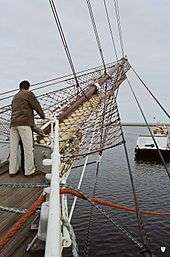Dar Pomorza
Coordinates: 54°31′10″N 18°33′10″E / 54.5194°N 18.5529°E
 Dar Pomorza in 2008 | |
| History | |
|---|---|
| Name: | Prinzess Eitel Friedrich |
| Builder: | Blohm & Voss, Hamburg |
| Launched: | 1909 |
| Name: | Dar Pomorza |
| Acquired: | 1930 |
| Decommissioned: | 4 August 1982 |
| Status: | Museum ship in Gdynia |
| General characteristics | |
| Class and type: | Sailing ship, full-rigged ship |
| Tons burthen: | 1561 gross tons, 525 net tons |
| Length: | 80 m (260 ft) (93 m full length) |
| Beam: | 12.6 m (41 ft) |
| Propulsion: | Auxiliary engine, 430 HP |
| Sail plan: | Full rigged ship, 1900 or 2100 square metres of sail |
| Complement: | Crew of 28, plus 150-200 cadets |
The Dar Pomorza is a Polish full-rigged sailing ship built in 1909 which is preserved in Gdynia as a museum ship. She has served as a sail training ship in Germany, France, and Poland. Dar Pomorza won the Cutty Sark Trophy in 1980.
History
The ship was built in 1909 by Blohm & Voss and dedicated in 1910 by Deutscher Schulschiff-Verein as the German training ship Prinzess Eitel Friedrich, named for Duchess Sophia Charlotte of Oldenburg, wife of Prince Eitel Friedrich of Prussia. Her yard no. was 202, her hull was launched on the 12th of October 1909. In 1920, following World War I, the ship was taken as war-reparations by Great Britain, then brought to France, where she was assigned to the seamen's school at St-Nazaire under the name Colbert. The ship was in 1927 given to Baron de Forrest as compensation for the loss of a sailing yacht. Due to the high costs of refurbishing the ship, she was sold in 1929.
Still bearing the name Prinzess Eitel Friedrich, she was bought by the Polish community of Pomerania for £7,000, as the new training ship for the Polish Naval Academy in Gdynia. She was given the name Dar Pomorza, which means "the gift of Pomerania". In 1930 the ship was repaired and fitted with an auxiliary diesel engine. The experience gained during rebuilding works enabled Danish shipbuilders of Nakskov to build a sail training vessel for their country, the Danmark (still in service). Worth noting is the fact that the ship made her first voyage under Polish colours named (temporarily) "Pomorze" (Pomerania). According to rumours, the name may have been changed in effort not to name a training ship after a lost one. The same German-written name bore the German pre-dreadnought battleship Pommern, lost (with all hands) during the Battle of Jutland in June 1916.
During the following years, she was used as a training ship, receiving the nickname "White Frigate". In 1934-1935 she traveled around the world (via Panama Canal). In 1937 a special voyage took her around the famous Cape Horn; thus she became first ship under Polish Colours to round the famous cape. In 1938 she took part at the famous meeting of Baltic sail training ships at Stockholm, regarded as the predecessor of all the post-war Operation Sail meetings, winning i. a. special respect from the skipper of Norwegian sail training vessel Christian Radich. During World War II she was interned in Stockholm. After the war she was brought to Poland and used as a training ship again.
In 1967 she made a 'second debut', calling at Montreal, Quebec, Canada, during the Expo-Fair and winning general respect for her and her country. In the 1970s she took part in several Operation Sail and Cutty Sark Tall Ships' Races, winning her first race in 1972, taking the 3rd place in 1973, the 4th in 1974 and winning the 1st place and Cutty Sark Trophy in 1980. She was one of several Blohm & Voss-built tall ships, most popular in the world at that time. Her importance to the World's maritime heritage is her origin - she is the younger sister of the (still existing) Grossherzogin Elisabeth, the World's first purpose-built sail training ship. As well, she is the first ship ever to carry the Polish Colours around the world in one voyage (1934–35), thus becoming incomparable to any other existing unit of her sort.
In September 1981 she undertook her last race to the Finnish harbour of Kotka. On 4 August 1982 she was decommissioned and festively replaced by the Dar Młodzieży as a training ship. Since 27 May 1983 she has been a museum ship in Gdynia (next to the Błyskawica). She is part of collection of National Maritime Museum in Gdańsk.
Her speed under sail averaged 5 knots, with a 17 knots maximum.

Sister ships
The three sister ships of Dar Pomorza also survive:
- Duchesse Anne (originally Großherzogin Elisabeth)
- Schulschiff Deutschland
- Statsraad Lehmkuhl (originally Großherzog Friedrich August)
See also
References
External links
| Wikimedia Commons has media related to Dar Pomorza. |
- Polish Maritime Museum: Dar Pomorza
- Photos of Dar Pormorza (Polish language, archived link)